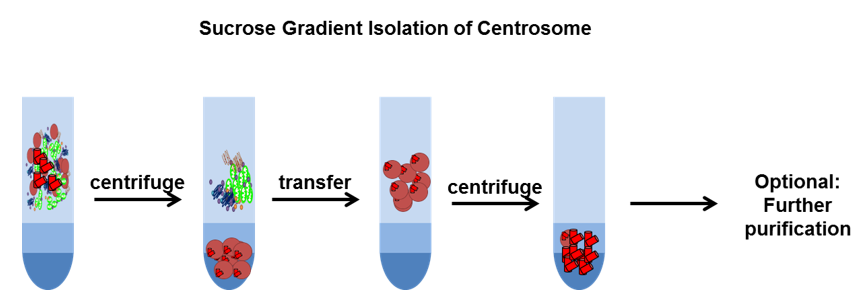Centrosome Isolation and Centrosome Protein Purification
Online InquiryCreative Proteomics offers centrosome isolation and centrosome protein purification services for animal tissues and cultured animal cells. Our service can help you obtain purified centrosome and centrosome proteins for subsequent assays.
Centrosome is a cytoplasmic organelle composed of two microtubule-based cylinders called centrioles, mainly found in animal cells. The centrosome is the primary microtubule-organizing center, and duplicated exactly once per cell cycle at the beginning of mitosis. The centrosome is evolutionarily conserved and has multifunction. Functional genomics analysis in some organisms has identified a small amount of conserved proteins required for the initiation of centriole/basal assembly and for centrosome reproduction. Besides, more than 100 proteins are localized in centrosome, among which some are diseases-related. To have better understanding of composition of centrosome, microtubule function, interaction of centrosome proteins, etc, isolation of centrosome and centrosome protein is the first and necessary step.
Advantages of Our Centrosome Isolation and Centrosome Protein Purification Services:
- Rich experience in centrosome separation and purification.
- Obtained pure centrosome with low impurities.
- Centrosome can be isolated and purified from animal tissues, culture animal cells, and some plants.
- Protein can be extracted from centrosome without intracellular proteins contamination.
- We will conduct purity verification tests to ensure that the isolated protein reaches the target purity, otherwise there is no charge.
We Provide the Following Services, including but not Limited to:
- Single organelle separation and purification
- Centrosome separation and purification
- Centrosome protein extraction
Methods of Centrosome and Centrosome Protein Extraction:
1. Single organelle – centrosome separation and purification

The centrosome is a small organelle (about 0.3 μM in diameter in mammalian cells), and usually there is only on copy in the cells. Besides, the density of centrosome is very high, so that it is hard to be purified by isopycnic density centrifugation. The step-gradient centrifugation is most commonly used method to isolate centrosome from cells, including sucrose gradient centrifugation, Ficoll gradient centrifugation, or combination. To isolate pure centrosome from cultured cells or animal tissues, sucrose gradient centrifugation will be conducted. A low ionic strength buffer can help centrosome detach from nuclei and intermediate filaments. After aggregation and centrifugation, chromatin can be removed, and centrosomes are sedimented onto a sucrose cushion and further enriched by sucrose gradient centrifugation. The centrosome isolated by this method can be used for subsequent experiments, including mass spectrometric analysis, and so forth. According to the purpose and different focus of the project, the centrosome can be further purified using immunomagnetic isolation procedure, which further improves the purity of isolated centrosomes. More specialized approaches will be conducted to meet your needs.
The purity requirements for centrosome purity determine the appropriate method required. Depending on your sample types, requirement of intact centrosome and subsequent experiment, different detergents and methods will be optimized to meet your needs.
2. Isolation and purification of multiple organelles
If you need multiple organelle proteins, then we will use the organelle fractionation method or filtration to separate and enrich the organelle proteins you need.
3. Extraction of centrosome proteins
To extract centrosome proteins, sucrose gradient centrifugation will be used to isolate centrosome first, and the protein will be extracted. Depending on your sample types and your project, different procedures will be optimized.
Delivery
Test design, purity analysis report, extracted centrosome and purified protein sample.
Want to learn more about centrosome proteins characterization, protein-protein interaction analysis, and other analysis services? We provide one-stop analysis of centrosome proteomics.
References
- Lehmann V., Muller H., and Lange B.M.H. Immunoisolation of Centrosomes from Drosophila melanogaster. Current Protocol in Cell Biology, 3.17.1-3.17.13 (2005).
- Meigs T.E. and Kaplan D.D. Isolation of Centrosomes from Cultured Mammalian Cells. CSH Protocols; 2008; doi:10.1101/pdb.prot5039.
- Bornens M., The Centrosome in Cells and Organisms. SCIENCE, VOL 335 27 JANUARY 2012.
* For Research Use Only. Not for use in diagnostic procedures.



